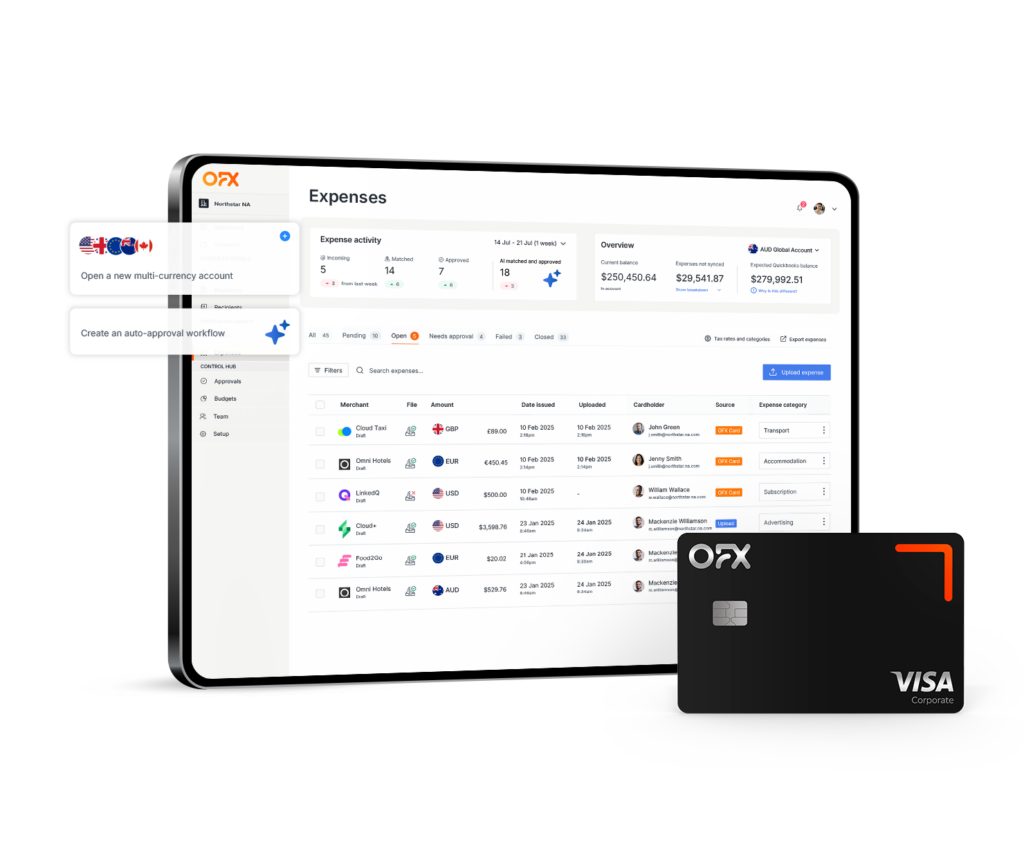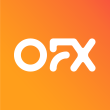In the last few years, how businesses manage their spending has changed dramatically. In the past, finance teams had to use spreadsheets and enter company expense data by hand. Now, with just a few clicks, they can keep track of expenses in real-time, pay staff back faster, and get valuable information about company spending.
If your business is still chasing staff for paper receipts or manually reconciling card transactions, it’s probably time to switch to expense management software. By automating routine tasks, you’ll free-up your team for high-value work that helps grow your business. Plus, you’ll have priceless data at your fingertips that aids with budgeting, forecasting, and identifying cost-cutting opportunities.
This guide will explain what expense management software does, what features to look for, and compare some of the best options available in the US right now. We’ll also explore why OFX Spend Management is a powerful solution for companies that need to manage spending end-to-end, both locally and globally.
Jump to:
• What is expense management software?
• How can expense management software improve manual expense processes?
• The top 10 expense management software platforms in the US
• What are the benefits of modern expense management systems
• Key features to look for in expense management solutions
• Expense management software comparison table
• Compare expense management platform pricing
• Choosing the right expense management software
• Best practices for implementing expense management software
• How expense management software saves time & money
• Why are businesses choosing to manage their expenses with OFX?
• Best expense management software FAQs
What Is Expense Management Software?
Expense management software is designed to make it easier for businesses to track, approve, and then reimburse spending.
The best solutions automate the entire expense management process, eliminating the need for manual data entry and giving finance teams up-to-date financial insights about company spending habits.
Though the specific features of different software solutions tend to vary, most typically include:
- Expense tracking with receipt capture or receipt scanning.
- Expense report creation with automatic categorization of different types of expenses.
- Approval workflows that enforce a company’s specific expense policies.
- Reimbursement processes to pay employees quickly and fairly.
- Accounting software integrations to ensure quick and accurate reconciliation.
By automating all of these steps, expense management software can reduce the chance of errors, save time, and ensure strict compliance with a company’s rules around expenses.
Smarter Spend Management with OFX
Track spend, issue corporate cards, and manage reimbursements all in one place with integrated expense management software

How can expense management software improve manual expense processes?
While no two platforms are the same, most expense management systems follow a similar basic structure:
- Submit expenses: Employees scan receipts or enter purchase details for their own expenses using a mobile app or desktop dashboard.
- Approve expenses: Managers review each expense and approve or reject based on company guidelines.
- Reimburse employees: Once approved, reimbursements are processed through integrated payroll or banking systems.
- Sync to accounting: All data is synced with your accounting software to keep financial records up to date.
However, with the right tools this system can be made even more efficient. Most modern software solutions also offer:
- OCR receipt scanning to capture data from paper receipts
- Automated approval workflows that match your internal processes
- Policy enforcement tools that ensure expense claims are compliant
- Multi-currency support for businesses with global operations
- Real-time expense reports for greater financial visibility
These features help reduce manual errors, eliminate unnecessary delays, and give finance teams the clarity they need to make well-informed decisions.
The Top 10 Expense Management Software Platforms in the US
The sheer number of expense management solutions available in the US is both a blessing and a curse. On one hand, businesses have a wide range of tools to choose from. Each offers different features, pricing models, and benefits. On the other hand, weighing up all these options is a difficult, time-consuming task.
To save you the trouble of manually comparing platforms, we’ve broken down the leading providers side by side. To make your choice even easier, we’ve grouped these options by the type of business they best serve.
For Growing Startups, Medium Size Businesses & Automation
If your business needs easy-to-use automation and reporting for everyday expense management, the following tools strike a good balance between simplicity and functionality.
OFX Spend Management 1
OFX brings expense management and international payments together in one place. With multi-currency accounts, corporate cards, and built-in financial tools, it saves businesses the hassle of having to juggle multiple platforms.
Key Features:
- Unlimited virtual and physical corporate cards with spending policies
- Automated OCR receipt capture and expense categorization
- Match receipts to transactions with intelligent AI automation
- Mobile app real-time expense tracking and re-imbursements
- Automated approval workflows and expense policy enforcement
- Accounting integrations with QuickBooks, Xero
- Multi-currency accounts, with the ability to spend 30+ currencies in over 170 countries at competitive rates.
Pros:
- Combines expense management and global payments in one platform.
- Strong support for multi-currency business expenses.
- Real-time visibility and reporting.
Cons:
- Digital-only platform (no physical branches).
Best For: Businesses with international operations that want both expense management and financial control in one system.
Expensify 2
Expensify is one of the longest-standing names in expense management. It is known for its user-friendly mobile app and simple automations.
Key Features:
- Receipt scanning and automatic expense categorization.
- Expense tracking and reimbursements.
- Mobile-first platform designed for simple use.
Pros:
- Easy to use with a clean, intuitive mobile app.
- Strong accounting software integrations.
- Automates expense reporting effectively.
Cons:
- Access to advanced features is restricted to higher-tier plans.
Best For: Businesses that want straightforward automation and an easy setup process.
Brex 3
Brex is aimed at startups and scale-ups. Its AI-driven expense review helps businesses ensure compliance while keeping costs down.
Key Features:
- Free plan for startups.
- AI-powered compliance enforcement.
- Virtual corporate cards.
- Real-time expense tracking and categorization.
Pros:
- Free entry-level plan available.
- Strong focus on policy compliance.
- Easy to issue virtual corporate cards.
Cons:
- Lacks some advanced enterprise features.
- Focused primarily on startups and growing teams.
Best For: Startups looking for cost-effective expense management.
Emburse 4
Emburse is focused on efficiency and compliance. Its autofill and analytics tools help finance teams reduce manual effort and identify trends in expense data.
Key Features:
- Autofill for quick expense report creation.
- Customizable reporting dashboards.
- Anomaly detection to ensure spend policy compliance.
- Approval workflows to reduce manual work.
Pros:
- Advanced analytics and reporting.
- Helps ensure compliance with company policies.
- Saves time on manual expense reporting.
Cons:
- The interface can be overly complex for smaller businesses.
- Higher pricing compared to many alternatives.
Best For: Businesses that want deep insights and the ability to quickly create custom reports.
For Larger Enterprises & Complex Needs
Bigger companies often need advanced features, such as integrations with enterprise resource planning (ERP) systems and strict compliance controls. The following platforms are designed to work at scale.
SAP Concur 5
SAP Concur (Concur Expense) is a heavyweight in the enterprise space. It is built for large organizations that need global travel and expense management alongside invoice management.
Key Features:
- Integration with SAP and ERP systems.
- Travel, expense, and invoice management in one place.
- Mobile app for capturing receipts and submitting expense reports.
- Configurable approval workflows for large teams.
Pros:
- Enterprise-grade solution with robust compliance features.
- Global travel and expense management.
- Flexible approval workflows.
Cons:
- Pricing is not transparent and requires custom quotes.
- Implementation can be time-intensive.
- Is often too complex and expensive for businesses with modest needs.
Best For: Large enterprises needing comprehensive travel and expense management.
Rippling 6
Rippling is unique in that it connects HR and finance in the same app. Employee data links directly with expense reporting, making policy enforcement and reimbursements much easier to manage.
Key Features:
- Unified HR and expense management platform.
- Policy-based approval workflows.
- Reimbursements tied directly to payroll.
- Employee spend tracking and controls.
Pros:
- Combines the functions of HR and finance.
- Automates reimbursements effectively.
- Flexible approval workflows.
Cons:
- It can be expensive for smaller teams.
- It may be too complex for companies needing only basic expense functionality.
Best For: Businesses that want HR and expense management in one platform.
Workday Spend Management 7
Workday Spend Management is designed for large enterprises that prioritize compliance, oversight, and deep analytics.
Key Features:
- Real-time reporting and financial data insights.
- Policy enforcement and approval flows.
- Budget management and spend controls.
- Enterprise-grade compliance features.
Pros:
- Strong compliance and oversight tools.
- Real-time spend visibility.
- Advanced budgeting and controls.
Cons:
- Requires significant implementation.
- More complex than many small businesses will need.
Best For: Large organizations with complex compliance requirements.
For Small Businesses
Small businesses usually prioritize affordability, ease of use, and a platform that can scale as a business grows. These providers match that criteria.
Zoho Expense 8
Zoho Expense is an affordable expense management solution that integrates with the rest of the Zoho suite. It is popular with small to medium-sized businesses.
Key Features:
- Travel and expense management in one platform.
- Customizable approval flows and expense policies.
- Mobile app for receipt capture.
- Strong analytics and reporting tools.
Pros:
- Cost-effective for small businesses.
- Robust reporting and travel features.
- Works smoothly with other Zoho apps.
Cons:
- Setup and configuration can be time-consuming.
- Limited integrations outside the Zoho suite.
Best For: Small to medium-sized businesses already using other Zoho products.
QuickBooks Online 9
QuickBooks Online is widely used by small business owners as accounting software. However, the platform’s built-in expense tracking makes it easy to manage expenses alongside payroll and invoicing.
Key Features:
- Integrated business expense tracker.
- Receipt scanning and expense categorization.
- Accounting, payroll, and reporting tools.
- Cloud-based for access anywhere.
Pros:
- All-in-one accounting and expense software.
- Affordable entry pricing.
- Easy for small business owners to use.
Cons:
- Limited automation compared to standalone expense software.
- No corporate cards.
Best For: Small businesses wanting accounting and expense management in one system.
For Travel and Expense Integration
If your team travels frequently, a platform that combines travel booking and expense management can save time and ensure compliance.
Navan 10
Navan (formerly TripActions) combines travel booking with expense management, making it perfect for companies with employees who travel regularly.
Key Features:
- Travel and expense management in one platform.
- Automatic policy enforcement.
- Receipt capture and expense tracking.
- Real-time alerts and reporting.
Pros:
- Simple integration of travel and expense.
- Automatic policy enforcement.
- Real-time visibility into travel expenses.
Cons:
- Focused on travel-heavy businesses.
- It may not be as valuable if your team mostly operates domestically.
Best For: Companies with frequent business travel that want to integrate travel and expense reporting.
What are the benefits of modern expense management systems
Modern expense management systems provide advantages that can directly impact your bottom line. By transitioning from manual processes to automated solutions, you can experience benefits across multiple areas of your business operations.
Operational Efficiency
- Reduced Processing Costs: Automated systems cut expense processing costs by up to 70% compared to manual methods 21
- Time Savings: OCR technology decreases data entry time by 50% or more 22, allowing your team to focus on strategic work
- Streamlined Workflows: Approval processes that once took weeks can be completed in days or even hours
For example, your accounting team can process hundreds of receipts in the time it previously took to handle dozens, saving hours, reducing errors, and letting your people stay focused on what really matters.
Financial Control and Visibility
- Error Reduction: Automated validation catches mistakes before they become costly problems
- Fraud Prevention: Built-in compliance checks flag suspicious activities, potentially saving expensive fraudulent claims
- Real-Time Reporting: Access to current spending data enables better budgeting and forecasting decisions
This level of visibility into spending patterns, makes it easier to spot potential cost-saving opportunities that could be missed with paper-based processes.
Enhanced Employee Experience
- Faster Reimbursements: Employees could receive their money back in days rather than weeks
- User-Friendly Interfaces: Mobile apps allow for receipt capture and submission anywhere
- Reduced Frustration: No more lost receipts or confusing submission processes
When your team spends less time managing expenses, workplace satisfaction improves. Employees appreciate efficient systems that respect their time and ensure prompt reimbursement.
Key features to look for in expense management solutions
As expense management technology evolves, certain features have become essential for businesses seeking efficiency and control. Here’s what to consider in 2025:
Must-Have Capabilities:
Automated Receipt Capture – Look for advanced OCR technology that extracts data with 99%+ accuracy from receipts, invoices, and bills, eliminating manual entry completely.
Corporate Card Integration – Real-time transaction syncing between your expense platform and corporate cards to provide instant visibility into spending, eliminate out of policy payments and help prevent fraud with automatic merchant identification.
Customizable Approval Workflows – Your solution should offer configurable multi-level approval paths that adapt to your organizational structure and spending thresholds.
Accounting Software Integration – Seamless connections with platforms like QuickBooks and Xero, are now standard expectations for data consistency.
Mobile Accessibility – Robust mobile apps that function offline and allow receipt scanning, expense submission, and approvals from anywhere are non-negotiable.
Best Expense Management Software: Comparison Table
| Software | Multi-Currency Support | Corporate Cards (Physical & Virtual) | Receipt Capture & Scanning | Automated Approval Workflows | Integrations with Accounting Software | Best For |
|---|---|---|---|---|---|---|
| OFX1 | ✅ | ✅ | ✅ | ✅ | ✅ | Businesses with international operations |
| Expensify2 | ✅ | ✅ | ✅ | ✅ | ✅ | Businesses wanting easy automation |
| Brex3 | ✅ | ✅ | ✅ | ✅ | ✅ | Startups and cost-conscious companies |
| Emburse4 | ✅ | ✅ | ✅ | ✅ | ✅ | Businesses needing spend insights and compliance |
| SAP Concur5 | ✅ | ❌ | ✅ | ✅ | ✅ | Large enterprises |
| Rippling6 | ✅ | ✅ | ✅ | ✅ | ✅ | Businesses wanting HR and finance together |
| Workday7 | ✅ | ❌ | ✅ | ✅ | ✅ | Large enterprises |
| Zoho Expense8 | ✅ | ❌ | ✅ | ✅ | ✅ | Small to medium-sized businesses |
| QuickBooks Online9 | ✅ | ❌ | ✅ | ❌ | ✅ | Small business owners and sole traders |
| Navan10 | ✅ | ✅ | ✅ | ✅ | ✅ | Businesses with frequent travel |
Compare expense management platform pricing
Here’s a high-level breakdown of the price range for each expense management platform:
- OFX: $25 per user/month for Full Suite11
- Expensify: $5-$18+ per user/month12
- Brex: $0-$12 per user/month13
- Emburse: $8-$12 per user/month14
- SAP Concur: Custom pricing15
- Rippling: $8-$29 per user/month16
- Workday: Custom pricing17
- Zoho Expense: $8–$12 per user/month18
- QuickBooks Online: $24–$140 per user/month19
- Navan: $0-$15+ per user/month20
Choosing the Right Expense Management Software
The best expense management software for your business will depend on your size, complexity, and whether you operate locally or globally. Here is our take:
- For startups and small businesses: Platforms like Brex and QuickBooks Online are options to consider. Brex offers corporate cards and compliance tools, while QuickBooks Online is handy for small business owners who want accounting software and expense tracking in one. If your company is small but starting to operate internationally, OFX gives you the tools needed to manage overseas employee expenses with complete confidence.
- For mid-sized businesses and global operators: OFX is a strong choice. It combines expense management with multi-currency accounts, unlimited corporate cards, and real-time reporting. In our experience, businesses benefit most when they can manage both domestic and international employee expenses from one platform.
- For large enterprises: SAP Concur, Rippling, and Workday Spend Management offer the advanced features, compliance controls, and ERP integrations that big organizations need. They are built to function on a large scale, though implementation is complex and costs can be high.
Before making a choice, be sure to carefully match the software to your business’s needs. The right expense management tools can simplify day-to-day operations, create a healthier financial culture, and support the growth of your business for years to come.
Best practices for implementing expense management software
Successful implementation of expense management software requires careful planning and execution. Here’s how to ensure your rollout delivers maximum value:
Pre-Implementation Planning
- Assemble your team: Involve key stakeholders from finance, IT, and HR early in the process to gain cross-departmental buy-in and address concerns proactively.
- Assess current workflows: Document your existing expense processes, identifying pain points and opportunities for improvement.
- Define clear policies: Update or create comprehensive expense policies that the software will enforce, ensuring they align with your business needs.
- Set measurable goals: Define what success looks like with specific KPIs such as processing time reduction and compliance improvement.
Implementation Strategies
- Start with a pilot: Launch with a small group of users to test functionality and gather feedback before company-wide deployment.
- Ensure system integration: Work with your IT team to confirm seamless integration with existing financial systems, ERP, and HR platforms.
- Customize thoughtfully: Configure the software to match your expense policies and approval workflows, but avoid over-customization that may complicate updates.
- Develop a communication plan: Create clear messaging about why you’re implementing the new system and how it benefits employees.
Measuring Success and ROI
- Track time savings: Measure the reduction in time spent processing expenses compared to your previous system.
- Monitor compliance: Check if policy violations decrease after implementation.
- Survey user satisfaction: Collect feedback on ease of use and feature adoption.
- Review cost savings: Calculate ROI by analysing reduced processing costs, error rates, and fraud prevention.
How expense management software saves time & money
Managing expenses manually isn’t just slow, it’s a drain on productivity. Receipts go missing, spreadsheets become outdated, and following up on approvals takes up time that could be spent on other high-value tasks. Modern expense management software changes that.
- Save time: Eliminate the back-and-forth with automated approvals and one-click receipt uploads.
- Reduce errors: Tools like OCR help extract accurate data from receipts, reducing manual input mistakes.
- Boost compliance: In-app policy enforcement means fewer out-of-policy claims and better audit trails.
- Increase visibility: Access real-time dashboards that track spending across departments, teams, and even countries.
- Streamline reimbursements: Shorten reimbursement times with direct deposits and auto-approval rules.
- Support smarter spending decisions: Centralise expense data so you can analyse trends and set informed budgets.
With the right software, you’ll spend less time managing expenses and more time managing your business.
Why are businesses choosing to manage their expenses with OFX?
If your business needs both local simplicity and global reach, OFX offers the best balance between automation, control, and multi-currency capabilities.
With OFX, you can:
- Automate approval flows and enforce expense policies.
- Issue unlimited corporate cards (physical and virtual)
- Automate receipt capture with OCR and track expenses in a mobile app
- Match receipts to transactions with Intelligent AI automation
- Integrate seamlessly with accounting software
- Get real-time cash flow visibility with 2-way sync to QuickBooks and Xero
- Manage multi-currency expenses backed by OFX’s foreign exchange expertise
- Send bulk batch payments domestically or internationally with ease
- Get 24/7 phone support, dedicated account manager and help onboarding
At OFX, we’ve found that organisations that modernize how they handle expenses save time, make fewer mistakes, and have better overall control with their finances. All this adds up to a more sustainable and profitable business. To discover how you can gain more control over your expenses with OFX, take our virtual tour and book a free demo with one of our OFXperts today.
Best expense management software FAQs
What is the best expense management software for businesses in USA?
The best software depends on your business size, budget, and needs. QuickBooks and FreshBooks are popular among smaller teams thanks to their simplicity and affordability. Zoho Expense also provides excellent value for growing SMBs. If your business deals with global transactions, OFX offers competitive multi-currency features designed to simplify international spending.
How does expense management software integrate with accounting systems?
Most platforms include built-in integrations or APIs for connecting with accounting software like QuickBooks, Xero, or Sage. Once connected, approved expenses are automatically synced for faster reconciliation and more accurate financial records. OFX integrates with QuickBooks and Xero to streamline international accounting workflows.
Can expense management software handle multi-currency expenses?
Yes. For businesses that operate across borders, multi-currency support is critical. OFX offers corporate multi-currency cards and accounts that let you spend in local currencies and avoid unnecessary exchange fees. Xero and SAP Concur also provide multi-currency capabilities, though without linked card functionality.
How does expense software help ensure compliance?
Most tools include custom policy settings and auto-flagging for non-compliant claims. This makes it easier to stay on top of tax rules, internal guidelines, and audit requirements. Digital trails for your expense management process also improve transparency and help reduce fraud or errors.
Are virtual cards supported in expense management software?
Some platforms, including OFX, offer virtual corporate cards. These are great for online purchases or controlling recurring software subscriptions. You can set spending limits, cancel cards instantly, and monitor usage in real time.
Can these tools reimburse employees automatically?
Yes. Many systems automatically reimburse expenses once a claim is approved. This reduces delays and cuts down manual banking tasks. You’ll need to connect your payroll or bank details to activate this feature.
Do these tools support virtual corporate cards?
Yes. Many platforms, including OFX, offer virtual cards that employees can use for online purchases. These cards help streamline spend control and make it easier to cancel or limit use for specific subscriptions, business trips, or departments.
What types of businesses benefit most from expense management software?
Any business with employee expenses can benefit, but especially those managing business travel, remote teams, or recurring international payments. From small startups to large established companies, having a strong expense management system can save time and improve cash flow.
Is expense software worth it for small teams?
Absolutely. Even small teams benefit from automated processes that reduce admin time, improve data accuracy, and offer real-time visibility into spend management. For growing businesses, scalable tools like OFX provide the flexibility to start small and expand with your needs.
What are the top expense management software solutions in USA in 2025?
Here are some of the top expense software solutions in the USA:
- OFX
- Expensify
- Emburse
- SAP Concur
- Workday
- Zoho Expense
- QuickBooks Online
- Navan
What’s the best option for managing global spending?
OFX stands out for US businesses managing international expenses. Its multi-currency cards, global account access, and international payment tools make it ideal for cross-border operations.
Looking for a better way to manage
your business expense?
Sources:
- https://www.ofx.com/en-cus/business/spend-management/
- https://www.expensify.com/
- https://www.brex.com/support/expense-management
- https://www.emburse.com/
- https://www.concur.com/en-us/expense-management
- https://www.rippling.com/expense-management
- https://www.workday.com/en-us/products/spend-management/overview.html
- https://www.zoho.com/us/expense/
- https://quickbooks.intuit.com/accounting/
- https://navan.com/product/expense-management
- https://www.ofx.com/en-us/business/pricing/
- https://www.expensify.com/pricing
- https://www.brex.com/pricing
- https://www.emburse.com/products/spend/pricing
- https://www.concur.com/en-us/expense-management
- https://www.outsail.co/post/how-much-does-rippling-cost
- https://www.workday.com/en-us/products/spend-management/expenses.html
- https://www.zoho.com/ca/expense/pricing/
- https://quickbooks.intuit.com/pricing/
- https://navan.com/pricing
- https://www.concur.com/en-us/resource-center/reports/forrester-improve-travel-expense-invoice-management-solution-to-drive-better-ex
- https://www.peeriosity.com/shared-services/articles/2018/04/improving-accounts-payable-processing-efficiency-through-ocr-technology/



